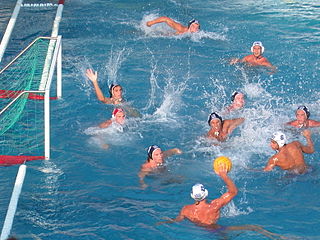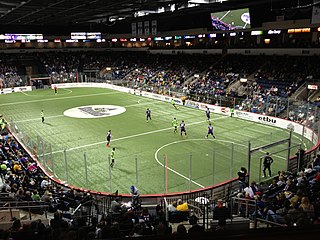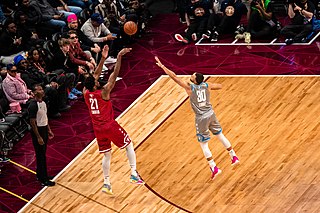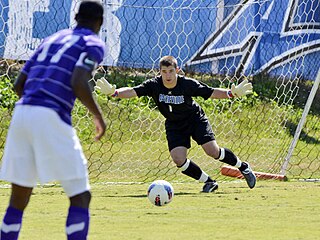Related Research Articles

Water polo is a competitive team sport played in water between two teams of seven players each. The game consists of four quarters in which the teams attempt to score goals by throwing the ball into the opposing team's goal. The team with the most goals at the end of the game wins the match. Each team is made up of six field players and one goalkeeper. Excluding the goalkeeper, players participate in both offensive and defensive roles. It is typically played in an all-deep pool where players cannot touch the bottom.

In many team sports that involve scoring goals, the goalkeeper is a designated player charged with directly preventing the opposing team from scoring by blocking or intercepting opposing shots on goal. Such positions exist in bandy, rink bandy, camogie, association football, Gaelic football, international rules football, floorball, handball, hurling, field hockey, ice hockey, roller hockey, lacrosse, ringette, rinkball, water polo, and shinty, as well as in other sports.

A penalty kick is a method of restarting play in association football, in which a player is allowed to take a single shot at the goal while it is defended only by the opposing team's goalkeeper. It is awarded when an offence punishable by a direct free kick is committed by a player in their own penalty area. The shot is taken from the penalty spot, which is 11 m from the goal line and centred between the touch lines.

Indoor soccer or arena soccer is a five-a-side or six-a-side version of minifootball, derived from association football and adapted to be played in walled hardcourt indoor arena. Indoor soccer, as it is most often known in the United States and Canada, was originally developed in these two countries as a way to play soccer during the winter months, when snow would make outdoor play difficult. In those countries, gymnasiums are adapted for indoor soccer play. In other countries the game is played in either indoor or outdoor arenas surrounded by walls, and is referred to by different names.
The Field Game is one of two codes of football devised and played at Eton College. The other is the Eton Wall Game. The game is like association football in some ways – the ball is round, but one size smaller than a standard football, and may not be handled – but the off-side rules – known as 'sneaking' – are more in keeping with rugby. There is also a small scrum or "Bully" of either six or seven a side. Goals can be scored much as in football, although there is no goalkeeper. But a team gains more points for scoring a 'rouge'. To score a rouge a player must kick the ball so that it deflects off one of the opposing players, or achieve a charge-down, and then goes beyond the opposition's end of the pitch. The ball is then 'rougeable' and must be touched – although not necessarily to the ground – by an attacking player to complete the rouge for five points. Rouges are similar to tries in that the scoring team then attempts to convert them for two points.

Field lacrosse is a full contact outdoor sport played with two opposing teams of ten players each. The sport originated among Native Americans, and the modern rules of field lacrosse were initially codified by Canadian William George Beers in 1867. Field lacrosse is one of three major versions of lacrosse played internationally. The rules of men's lacrosse differ significantly from women's field lacrosse. The two are often considered to be different sports with a common root. An outdoor six-a-side version, lacrosse sixes, was established in 2021 and features six players per team, reduced field size, and shorter duration to be conducive for daily tournament play. Another version, indoor box lacrosse, is also played under different rules.

In United States colleges, top-tier basketball is governed by collegiate athletic bodies including National Collegiate Athletic Association (NCAA), the National Association of Intercollegiate Athletics (NAIA), the United States Collegiate Athletic Association (USCAA), the National Junior College Athletic Association (NJCAA), and the National Christian College Athletic Association (NCCAA). Each of these various organizations is subdivided into one to three divisions, based on the number and level of scholarships that may be provided to the athletes. Teams with more talent tend to win over teams with less talent.

A three-point field goal is a field goal in a basketball game made from beyond the three-point line, a designated arc surrounding the basket. A successful attempt is worth three points, in contrast to the two points awarded for field goals made within the three-point line and the one point for each made free throw.

A goalkeeper is a position in association football. It is the most specialised position in the sport. The goalkeeper's main role is to stop the opposing team from scoring. This is accomplished by having the goalkeeper move into the trajectory of the ball to either catch it or direct it further from the vicinity of the goal line. Within the penalty area goalkeepers are allowed to use their hands, giving them the sole rights on the field to handle the ball. The goalkeeper is indicated by wearing a different coloured kit from their teammates and opposition.

The Drexel Dragons are the athletic teams of Drexel University in Philadelphia, Pennsylvania.

The Jacksonville Dolphins are the intercollegiate athletics teams that represent Jacksonville University, located in Jacksonville, Florida. The Dolphins participate in NCAA Division I athletics, and are primarily members of the ASUN Conference. Some teams in sports that are not sponsored by the ASUN play in other conferences; specifically, the men's and women's rowing teams are in the Metro Atlantic Athletic Conference. The men's lacrosse team had played in the Southern Conference (SoCon) from 2015 to 2022, but that sport will return to the ASUN for the 2023 season.
Basketball is a ball game and team sport in which two teams of five players try to score points by throwing or "shooting" a ball through the top of a basketball hoop while following a set of rules. Since being developed by James Naismith as a non-contact game that almost anyone can play, basketball has undergone many different rule variations, eventually evolving into the NBA-style game known today. Basketball is one of the most popular and widely viewed sports in the world.

Lassi Elias Hurskainen is a Finnish footballer, who played as a goalkeeper for UNC Asheville Men's Soccer before graduating from UNC Asheville in Fall of 2011.
The 2013 NCAA Division I men's soccer season was the 55th season of NCAA championship men's college soccer. There were 203 teams in men's Division I competition. The defending champions were the Indiana Hoosiers who defeated the Georgetown Hoyas in the 2012 College Cup. The season concluded with Notre Dame defeating Maryland 2–1 to win its first NCAA soccer title.

The 2016 SIU Edwardsville Cougars men's soccer team represented Southern Illinois University Edwardsville during the 2016 NCAA Division I men's soccer season, the school's 50th season. The Cougars were coached by Mario Sanchez. The team played their home games on Bob Guelker Field at the Ralph Korte Stadium as an affiliate member of the Missouri Valley Conference (MVC).

A free kick is a method of restarting play in association football. It is awarded after an infringement of the laws by the opposing team.
References
- ↑ Negley, Cassandra. "From Thomasville Bulldog to West Point cadet". Thomasville Times-Enterprise. Retrieved 2019-02-24.
- ↑ "Men's Soccer Individual Records". Western Michigan University Athletics. Retrieved 2019-02-24.